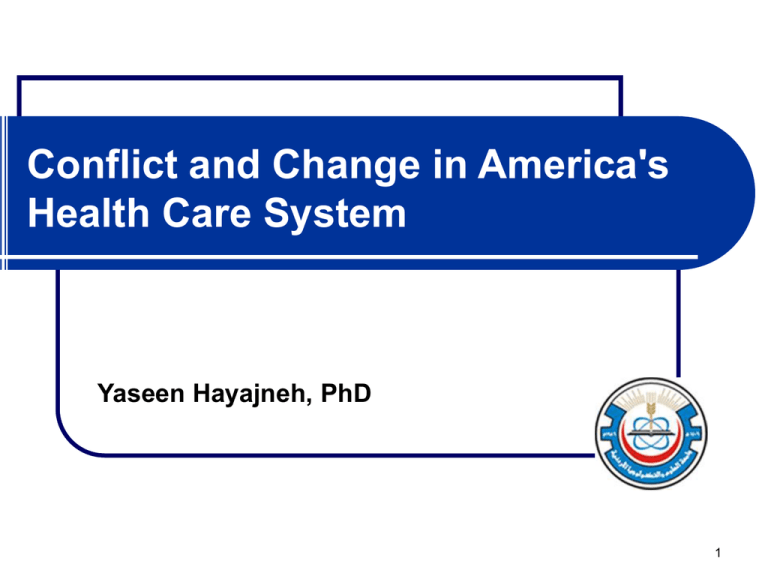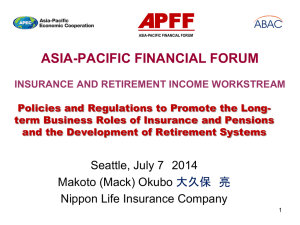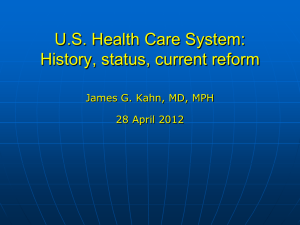Conflict and Change in America`s Health Care System
advertisement

Conflict and Change in America's Health Care System Yaseen Hayajneh, PhD 1 Major Actors in Any Health Care System 1. Purchasers 2. Supply the funds. Individuals, businesses, and government. Ultimately individuals are the purchasers. Government and businesses are major player as the organize purchasers of health care Insures Receive money from the purchasers and reimburse the providers. Assume risk Government and businesses assume the rule of insurer when they pay providers directly. 2 Major Actors in Any Health Care System 3. Providers 4. Hospitals, physicians, nurses and others.. who actually provide the care. HMOs may be viewed as Insurer and provider Government as provider. Suppliers Pharmaceutical and medical supply industries Manufacture equipment, supplies and medicaitons. 3 The Basics Health Care Industry Insurers, Providers and Suppliers Purchasers wish to reduce spending, while the HC Industry wishes to increase spending. 4 1945-1970: Provider-Insurer Pact Independent hospitals and small private practices. Limited supply of providers > Competition was minimal between providers. HC industry was marked by an ALLIANCE between Insurers and Providers. Many private insurers. Blue Cross – American Hospital Association Blue Shield – State Medical Associations & AMA Providers dominated insurers, especially blue cross and blue shield. 5 1945-1970: Provider-Insurer Pact Reimbursements for providers were generous. Insurers paid without asking questions Purchasers (individuals, business, and government) had relatively little power. In 1960s the pact was so strong Dictated the reimbursement provisions of Medicare and Medicaid. 6 1945-1970: Healthy Economy Businesses paid with little interest to question increases in cost American businesses controlled domestic and foreign markets without serious competition. Economy was in a good shape Government subsidized health insurance. 7 Provider-Insurer Pact: Results Costs of health care inflated at a rapid pace. Between 1962 and 1978 costs had rised about 10% per year. 8 The 1970s: Tension develop Japan and Europe competed US for markets. US economy weakened. Between 1970 – early 1990s, unemployment and inflation in US. Purchasers (especially government) become concerned about costs of health care. Under pressure from purchasers, insurers begin to question generous reimbursements of providers. Early 1970s control of hospitals and physicians over the blues was loosened. 9 The 1980s: Revolt of the Purchasers Economy still in trouble. Late 1980s cost of health insurance jumped about 40% in two years (1988-89). Self insurance: by 1991, 40% of employees were self-insured by their employers. Percentage of total payroll paid on insurance is about 10% (1988). Double that of 1976. Businesses carried the risk for HC expenditures. Businesses’ goal to control costs of health care. 10 The 1980s: The Rise of Managed Care Purchasers Private Insurers Businesses shifted to managed care (HMOs) as a cost-control device. Shift from FFS to Capitation Shift risk for purchasers and insurers to providers. increased dramatically premiums Increased policy cancellations for chronic patients. Government PPS and DRGs Controlled Medicare hospital costs Outpatient Medicare costs and private purchasers costs escalated. Reduce Medicaid but was forced later to increase it. Started to experiment with managed care. 11 The 1980s: Revolt of the Purchasers Selective contracting Purchasers and insurers will do business only with providers who keep cost down Patients lost choice Purchasers revolt led to Managed care became the dominant in heath care. 12 The 1990s: Breakup of provider-insurer pact Providers formed networks Hospital systems instead of independent hospitals. Providers started to compete for contracts and patients. Selective Contracting continued Patients’ choice of provider became limited. The 1990s was a period of purchaser dominance. Purchaser groups formed coalitions to negotiate with HMOs Enrollment in HMOs doubled in the 1990 (40-80 millions) 13 1990s: Bargaining Power To improve bargaining power, purchasers, insurers and providers consolidated. HMOs merged together. Providers also consolidated By 2000, 80% of hospitals were members of multihospital systems. 14 1990s: …Conclusion Price competition is introduced. Large physician groups emerge. Insurance companies dominate many managed care markets. For-profit institutions increase in importance. Insurers gain increasing power over providers, creating conflict and ending the providerinsurer pact. Pharmaceutical companies… 15









